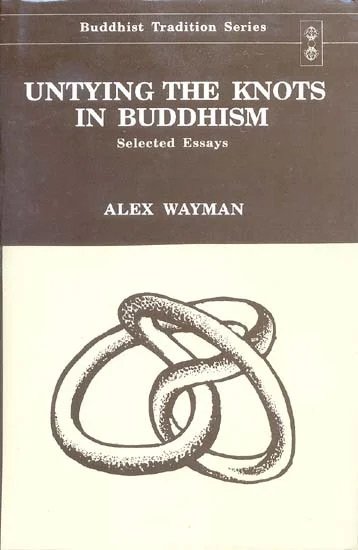Untying the Knots in Buddhism
author: Alex Wayman
edition: 1997, Motilal Banarsidass Publishers Pvt. Ltd.
pages: 631
ISBN-10: 8120813219
ISBN-13: 9788120813212
Topic: Buddhism
Preface
There are two kinds of articles in the present work ones previously published and ones not previously published. In the latter group there are those prepared for special purposes and those composed especially for the present work.
May I thank jointly the various editors and organizations, etc. who or which have given permission for reprinting various articles in the present volume.
Especially must I thank Marisusai Davamony editor of the annual periodical Studia Missionalia in Rome for the numerous invitations to contribute essays and permission to reprint certain ones for this volume namely with their dates of original publication Sakyamuni, founder of Buddhism 1984. Nagarjuna reformer of Buddhism (1985) Vasubandhu Teacher Extraordinary (1988) The Guru in Buddhism (1987) The Buddhist (1991).
Indian books center Delhi India for permission to reprint Doctrinal affiliation of Asanga from the Prof. P.V. Bapat Felicitation volume Amala Prajna Aspects of Buddhist Studies (1989).
V.C. Srivastava Dept of ancient Indian History culture & chaeology, Banaras Hindu University for permission to reprint ‘Parents of Buddhist Monks” from Bharati, 1966-68, Nos. X & XI.
Philosophy East and West (Hawaii), for reprinting “Tathagata Chapter of Nagarjuna’s Madhyamaka-karika,” from its Vol. 38 (1988), pp. 47-57; and for “The Meaning of Unwisdom” [now “The meaning of Nescience” with other corrections], from its Vol. 7 (1957), pp. 21-5.
The American Oriental Society for permission to use my translation of Madhyamaka-karika, Chap. II, from my article The gait (gati) and the Path (marga)—.Reflections on the Horizontal,” Journal of the American Oriental Society, 105.3 (1985).
The Adyar Society Bulletin for permission to use the article “The Vedic Three Worlds in Early and Later Times,” from its Vol. 50, 1986.
The Faculty of Asian Studies, The Australian National University, Canberra for permission to reprint “Vedantic and Buddhist Theory of Nama-rupa,” from the J.W. de Jong volume Indological and Buddhist Studies (Canberra, 1982).
The Central Institute of. Higher Tibetan Studies, Samath, Varanasi for permission to use the article (cf. my essay No. 13) “A Prajñãpãramit’A Scripture within a Tantra,” from ramana Vidya (1987).
Kluwer Academic Publishers, Dordrecht, The Netherlands for permission to reprint (although with a few deletions) my “Studies in Yama and Mara,” Indo-Iranian Journal, 1959, 3:1. pp. 44-75; 3:2, pp. 112-131.
Genjun H. Sasaki, D. Litt., who gave permission on behalf of the publisher Shimizukobunda Ltd., Tokyo, for reprinting “Purification of Sin in Buddhism by Vision and Confession” from the work he edited A Study of Klea (1975).
Alex Wayman, since his essay No. 16 “Asañga on Food” is from his own Analysis of the Sravakabhumi Manuscript (Berkeley, California, 1961) and after this work went out of print, one need not ask the publisher for permission.
Articles prepared for specific purposes: “Aniconic and iconic art of the Buddha” was delivered in a panel of the College Art Association, during its 1989 San Francisco meeting.
“Prophecies for Persons” was delivered as a Faculty lecture at the University of Hawaii, Fall 1992.
“The ‘no-self’ of Buddhism within Indian Culture” after being written in full extent was reduced for presentation at a meeting of the Society for Asian and Comparative Philosophy at New York City, in Dec., 1991.
Articles written especially for the present volume: “Asañga’s Three Pratyeka Buddha Paths” is based on my published edition of Asañga’s Pratyeka buddhabhumi in Journal of Indian and Buddhist Studies, 7:1 (Tokyo, 1960).
“Core Teachings: suffering, karma, seed consciousness, dharma” was especially composed for the present volume.
The articles “The Buddha date and era” and “Virtue consignment (parinamana)” were composed for the present volume, but while in Varanasi a few years back, I allowed Prof. A.K. Narain to include the former one in a seminar volume on the date of the Buddha he was editing; and allowed Prof. N.H. Samtani to include the latter in a seminar volume on Buddhist terminology he was editing, informing both scholars that the two essays were meant for the volume Untying the knots. I have no information as to whether either of those seminar volumes was published.
Also composed especially for the present volume were in essay no. 13, on voidness, the translation from Pãli of the Culasunhatäsutta; in essay no. 14, the scripture’ part translated from the Tibetan prologue to the Aksayamatinirde.a-sutra; in essay no. 20, additions to the Buddhist theory of the three worlds; and in essay no. 24, the pan -the meaning of omniscience”.
After accounting for the essays in this volume, may I take this opportunity to thank Shree N. Prakash Jam, Director, Motilal Banarsidass. Delhi. India, for undertaking to publish the present work in the Buddhist Tradition Series for which I am the general editor.
